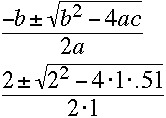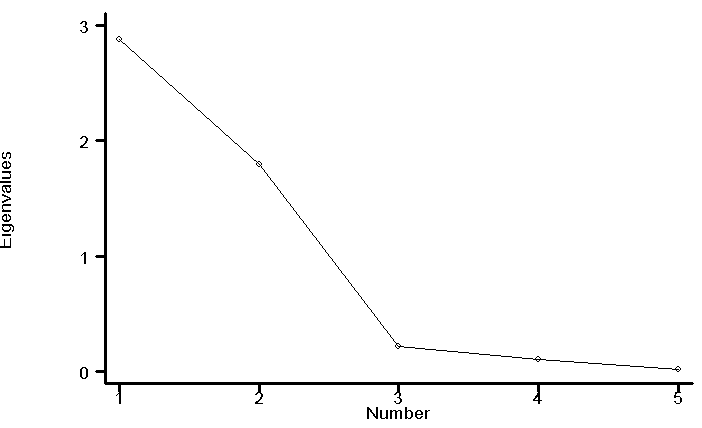
In principal components analysis we attempt to explain the total variability of p correlated variables through the use of p orthogonal principal components. The components themselves are merely weighted linear combinations of the original variables.
The first principal component can be expressed as follows,
Next, principal component Y2 is formed such that its variance, λ2 is the maximum amount of the remaining variance and that it is orthogonal to the first principal component. That is, a1'a2 = 0.
One continues to extract components until some stopping criteria is encountered or until p components are formed. It is possible to compute principal components from either the covariance matrix or correlation matrix of the p variables. If the variables are scaled in a similar manner than many researchers prefer to use the covariance matrix. When the variables are scaled very different from one another than using the correlation matrix is preferred. A common stopping criteria when using the correlation matrix is to stop when the variance of a component is less than one.
The weights used to create the principal components are the eigenvectors of the characteristic equation,
The eigenvalues are obtained by solving |S - λiI| = 0 for λi.
Consider the folllowing correlation matrix:
matrix list r
symmetric r[2,2]
c1 c2
r1 1
r2 .7 1
matrix symeigen a l = r
/* eigenvalues */
matrix list l
l[1,2]
e1 e2
r1 1.7 .3
matrix list a
/* eigenvectors */
symmetric a[2,2]
e1 e2
r1 .70710678 .70710678
r2 .70710678 -.70710678
The equation for the eigenvalues can be expressed as solving for the determinant of

and setting it to zero, which reduces to

yields the two roots of 1.7 and .3. These roots are the eigenvalues also know as the characteristic values or characteristic roots. Once you have obtained the eigenvalues you use them to obtain a solution for the eigenvectors.
It is possible to interpret the eigenvectors directly but most researchers also look at the correlations between the components and the variables. These correlations are known as the component loadings.
Principal Components Analysis Example
The following example uses data for five socio-economic variables for 12 different locations. The variables are total population, median schooling, total employed, misc. professional services, and median housing value. The data are from Harman (1976).
use http://www.gseis.ucla.edu/courses/data/harman1
pca pop medsch employ profser medhouse, means
(obs=12)
Variable | Mean Std. Dev. Min Max
----------+----------------------------------------------------
pop | 6241.667 3439.994 1000 9900
medsch | 11.44167 1.786545 8.3 13.7
employ | 2333.333 1241.212 400 4000
profser | 120.8333 114.9275 10 390
medhouse | 17000 6367.531 9000 25000
(principal components; 5 components retained)
Component Eigenvalue Difference Proportion Cumulative
------------------------------------------------------------------
1 2.87331 1.07665 0.5747 0.5747
2 1.79666 1.58182 0.3593 0.9340
3 0.21484 0.11490 0.0430 0.9770
4 0.09993 0.08468 0.0200 0.9969
5 0.01526 . 0.0031 1.0000
Eigenvectors
Variable | 1 2 3 4 5
----------+------------------------------------------------------
pop | 0.34273 0.60163 0.05952 0.20403 0.68950
medsch | 0.45251 -0.40641 0.68882 -0.35357 0.17486
employ | 0.39669 0.54167 0.24796 0.02294 -0.69801
profser | 0.55006 -0.07782 -0.66408 -0.50039 -0.00012
medhouse | 0.46674 -0.41643 -0.13965 0.76318 -0.08243
greigen

Next we will use data from the high school and beyond survey.
use http://www.gseis.ucla.edu/courses/data/hsb2
pca read write math science
(obs=200)
(principal components; 4 components retained)
Component Eigenvalue Difference Proportion Cumulative
------------------------------------------------------------------
1 2.85491 2.41937 0.7137 0.7137
2 0.43554 0.06172 0.1089 0.8226
3 0.37382 0.03810 0.0935 0.9161
4 0.33573 . 0.0839 1.0000
Eigenvectors
Variable | 1 2 3 4
-------------+-------------------------------------------
read | 0.50714 -0.22100 -0.54927 0.62632
write | 0.48572 0.82012 0.27120 0.13393
math | 0.51124 -0.05078 -0.38296 -0.76772
science | 0.49550 -0.52535 0.69145 0.01980
pca read write math science, cov
(obs=200)
(principal components; 4 components retained)
Component Eigenvalue Difference Proportion Cumulative
------------------------------------------------------------------
1 272.11643 231.66023 0.7147 0.7147
2 40.45620 3.10970 0.1063 0.8209
3 37.34649 6.50385 0.0981 0.9190
4 30.84264 . 0.0810 1.0000
Eigenvectors
Variable | 1 2 3 4
-------------+-------------------------------------------
read | 0.54030 -0.19508 -0.73149 -0.36734
write | 0.46626 0.79436 0.27230 -0.27829
math | 0.48540 0.05035 -0.09084 0.86810
science | 0.50504 -0.57306 0.61848 -0.18444
predict cs1 cs2
(based on unrotated principal components)
(2 scorings not used)
Scoring Coefficients
Variable | 1 2
-------------+---------------------
read | 0.54030 -0.19508
write | 0.46626 0.79436
math | 0.48540 0.05035
science | 0.50504 -0.57306
corr cs1 cs2
(obs=200)
| cs1 cs2
-------------+------------------
cs1 | 1.0000
cs2 | 0.0000 1.0000
regress socst read write math science
Source | SS df MS Number of obs = 200
-------------+------------------------------ F( 4, 195) = 44.49
Model | 10944.2858 4 2736.07144 Prob > F = 0.0000
Residual | 11991.9092 195 61.4969704 R-squared = 0.4772
-------------+------------------------------ Adj R-squared = 0.4664
Total | 22936.195 199 115.257261 Root MSE = 7.842
------------------------------------------------------------------------------
socst | Coef. Std. Err. t P>|t| [95% Conf. Interval]
-------------+----------------------------------------------------------------
read | .380752 .0800116 4.76 0.000 .2229529 .5385511
write | .3751806 .0803521 4.67 0.000 .2167099 .5336512
math | .1322237 .0889155 1.49 0.139 -.0431359 .3075833
science | -.0279416 .0793993 -0.35 0.725 -.1845333 .12865
_cons | 7.206027 3.611316 2.00 0.047 .0837748 14.32828
------------------------------------------------------------------------------
/* regression using principal component scores */
regress socst cs1 cs2
Source | SS df MS Number of obs = 200
-------------+------------------------------ F( 2, 197) = 83.68
Model | 10535.0947 2 5267.54734 Prob > F = 0.0000
Residual | 12401.1003 197 62.9497478 R-squared = 0.4593
-------------+------------------------------ Adj R-squared = 0.4538
Total | 22936.195 199 115.257261 Root MSE = 7.9341
------------------------------------------------------------------------------
socst | Coef. Std. Err. t P>|t| [95% Conf. Interval]
-------------+----------------------------------------------------------------
cs1 | .4307223 .0340952 12.63 0.000 .3634839 .4979607
cs2 | .2464224 .0884256 2.79 0.006 .0720402 .4208047
_cons | 6.214682 3.632656 1.71 0.089 -.9492029 13.37857
------------------------------------------------------------------------------
/* anova using principal component scores */
anova cs1 prog
Number of obs = 200 R-squared = 0.2154
Root MSE = 14.6861 Adj R-squared = 0.2074
Source | Partial SS df MS F Prob > F
-----------+----------------------------------------------------
Model | 11661.6631 2 5830.83154 27.03 0.0000
|
prog | 11661.6631 2 5830.83154 27.03 0.0000
|
Residual | 42489.5075 197 215.682779
-----------+----------------------------------------------------
Total | 54151.1706 199 272.116435
Multivariate Course Page
Phil Ender, 15oct05, 25may02; 29jan98